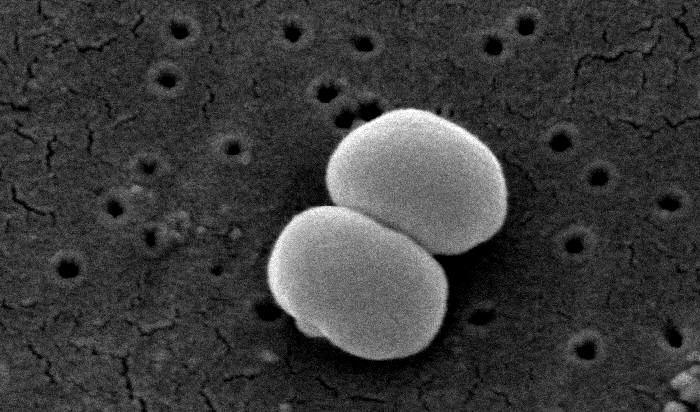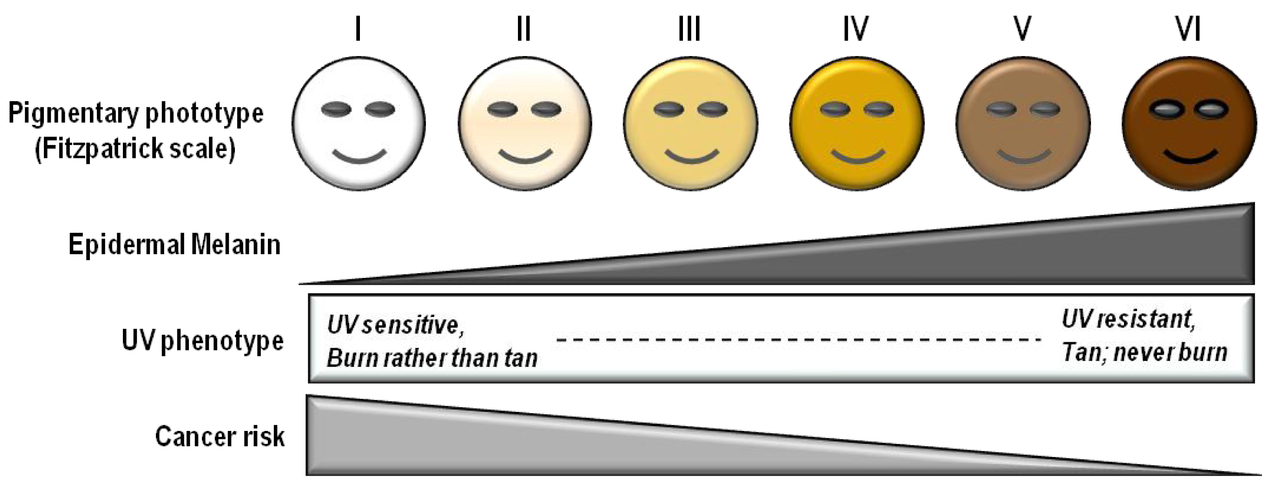
Staphylococcus epidermidis . Usually peaceful, but can provoke acne if you get too hungry.
Our skin is a zoo. Moreover, the open type, with different "climatic" zones and biomes. The safari program includes about 1000 species of various bacteria and fungi. In healthy people, this whole microbiosystem lives in harmony and harmony, eats each other, the remnants of what our skin has secreted, and does not allow especially evil species that would not mind eating our skin. If the ecological balance is disturbed, then in the first place there are inflammatory foci, which are usually called acne.
To prevent this from happening, you need to monitor the food chains of conditionally beneficial species and destroy conditionally harmful ones. Derivatives of sulfur and azelaic acid help a lot in this. Now I'll tell you what interesting things we managed to collect from these components, how it works and what does sex hormones and tanning have to do with it.
There are usually three main biomes on the skin: oily, dry, and wet. Each of them has its own set of organisms, which is optimally adapted to life in this zone. For example, the navel is a typical wet area. No exposure to harmful ultraviolet radiation, no sebaceous glands, warm and humid. Therefore, it is often considered a reference site for research on the
We even organized a special Belly Button Biodiversity Project .

Colonies of Pseudomonas aeruginosa , one of the key inhabitants of our skin
Microorganisms are trying in every possible way to oust competitors and occupy their ecological niche. As a result, a side effect of their vital functions is the stimulation of our immunity and the synthesis of various toxins with which they are trying to poison competitors. For example, Pseudomonas aeruginosa synthesizes pseudomonic acid, which successfully inhibits the growth of staphylococci, streptococci, and yeast-like fungi like the genus Candida. It is pseudomonic acid that is a component of the antibiotic mupirocin.
In the event that such a key organism experiences problems, opportunistic organisms such as Staphylococcus aureus immediately take its place and begin to aggressively attack our skin.
Greasy microbiome
But today we are interested in who "lives" in the ducts of the sebaceous glands, especially in the face area, as well as in the meibomian glands, which form the tear film. We wrote about them earlier when we talked about dry eye syndrome .
It is in this zone that disturbances in the synthesis of sebaceous secretions lead to the development of ostiofolliculitis, acne and other inflammatory processes.
Cutibacterium acnes was called Propionibacterium acnes until 2016 , but has been renamed based on genetic studies. This type of bacteria belongs to the slow-growing gram-positive facultative anaerobes. That is, he prefers places without oxygen, but the presence of air does not terrify him.
They live mainly inside the ducts of the sebaceous glands and feed on their secretions, destroyed cellular remains and various products of our metabolism. In healthy skin, they coexist quite peacefully with us and do not cause any special problems.
Everything becomes worse if the synthesis of the sebaceous secretion is disrupted . For example, when the glands, in response to continuous washing with aggressive detergents, try to replace the washed off sebum, or when the ducts of the sebaceous glands are blocked. In this case, the duct of the sebaceous gland ceases to cope with the flushing of excess cutibacteria onto the surface of the skin along with the sebaceous secretion. Bacteria begin to rejoice in excess food, lack of air and actively multiply.
They also secrete a large number of digestive enzymes, partially digesting and damaging the follicle walls. As a result, the violation of the integrity of the cell layer lining the follicle, the accumulation of the remains of dead bacteria and their waste products becomes a trigger of inflammation . Our keratinocytes have specific toll-like receptors (TLRs) that are required to activate immediate immune responses. It is precisely them that are activated by Cutibacterium acnes , or rather, TLR-2 and TLR-4 . And then the classic inflammation, alarmed macrophages, raised on alarm, parachuting into the tissue through the vessels, which have become permeable.
Also, damaged skin becomes an easier target for colonization by such a conditional pathogen as Staphylococcus aureus. And even such a natural inhabitant as Staphylococcus epidermidis begins to actively reproduce, trying to break through the weakened barriers.
And now we already have "acne" - small pustules, papules, folliculitis.
For squeeze lovers
By the way, I just want to warn those who like to squeeze out acne. With traumatic opening of a pustule, you break the barrier that separates the site of inflammation from healthy tissue, and you can potentially provoke Cutibacterium acnes , a more severe purulent process. It is a very bad idea to try to squeeze out the abscess in the area of the nasolabial triangle. Venous outflow in this area is very specific and is realized through the vascular system of the brain. Plus, there are no venous valves, so the infection instantly flies into the cavernous sinuses and can lead to their thrombosis, brain abscess and meningitis. In general, I do not recommend it.
Melanoses
Any damage does not pass without a trace for our body. If the skin is severely injured, then you can get a formed area of connective tissue - a scar. If the injury is less critical and is, for example, a consequence of chronic inflammation, then you can get a change in the structure of the skin in this area. A typical consequence of such foci of inflammation is melanosis - a local violation of melanin synthesis and hyperpigmentation. A speck of a darker color remains on the face than the surrounding skin. When acne does not go away for a long time, we get an uneven patchy appearance of the skin, which often leads to not very beautiful aesthetic defects.

If you rely on the Fitzpatrick phototype scale, you will notice that the severity of melanosis depends on the phototype. People with a Celtic phototype practically do not synthesize melanin, and post-inflammatory melanosis is mild in them. In the Negroid phototype, melanin synthesis, on the contrary, is very intense, but the areas of hyperpigmentation are hardly noticeable against the background of very dark skin. The most contrasting areas of darkening appear on the skin of people with dark European and Mediterranean skin types.
What did we manage to create

In our laboratory, we worked a lot on this problem and as a result came to a rather complex composition of several key substances that maximally target the pathogenesis of the disease.
It all depends on in what phase the acne treatment begins. If the patient is in remission, but in any incomprehensible situation comedones are formed, the skin becomes oily, and acne appears, then you can do with only one sulfur-containing drug. In our line, this is Demoten . We talked about it beforewhen we studied what would happen if more than five ticks per square centimeter were found on the face. It contains sulfur compounds that prevent anaerobic bacteria from overgrowing, and also severely poison the life of the demodex mite. And even with deep delivery into the ducts of the sebaceous glands, sulfur reduces the level of their secretion. It is quite difficult to organize in combination with skin hydration, but transdermal delivery of substances is one of the specialties of our laboratory.

Chemical structure of azelaic acid
If inflammation is already in the active phase, then it makes sense to supplement therapy with azelaic acid. We have it in the Stop-Acne serum .
It has a rather intense irritant potential and in most products containing azelaic acid, as a rule, such side effects as dry skin and irritation are manifested. We were able to add it to the formula as a complex with glycine. At the same time, all the therapeutic effects of azelaic acid are present, and there is almost no irritation, despite the rather high concentration.
What does azelaic acid do? Most of its effects are due to the blockade of various enzymes.
The color of our skin is determined by specific polymers - melanins. There are two types found in the skin - eumelanins and pheomelanins. Eumelanins are dark brown, while pheomelanins are reddish. It is pheomelanins that stain the areola of the nipples, the skin of the genitals and give color to freckles. Their synthesis is possible thanks to the enzyme tyrosinase, which works as a catalyst in the chain of the amino acid tyrosine → DOPA → DOPA-chromium → melanins. If it is inhibited with azelaic acid, the synthesis of melanins stops, which leads to the maintenance of a uniform light skin tone.
Azelaic acid also has a direct bacteriostatic effect against bacteria that cause inflammation of the skin. It also reduces the production of keratin, the very protein that makes up our skin's scales. The same saprophytic bacteria eat it with pleasure, watering it with proteases.
Finally, it reduces the activity of the type I 5-alpha reductase enzyme, which I want to discuss separately.
Sex hormones and acne
I think that in adolescence, each of us experienced acne to one degree or another. Usually, all this unpleasant situation resolves itself by the age of 17–20, when hormonal changes end. At the same time, some people suffer from the so-called acne adultorum - adult acne. It happens more often in women than in men. Moreover, in women, this is often accompanied by various pathologies of the genital area - for example, hyperandrogenism. This may be due to the synthesis of excessive amounts of male sex hormones or as a result of increased sensitivity of target cells at normal hormone levels.
The reason the skin is so sensitive to hormones is in the cells of the sebaceous glands. They have some hormonal activity and are able, with the participation of the 5-alpha reductase enzyme, to convert testosterone into its more active form - dihydrotestosterone. And already he, in turn, activates the process of growth and maturationsebocytes. In fact, in a simplified way, the chain looks like this: more active testosterone → more production of sebaceous gland secretion → more food for anaerobic bacteria. Moreover, the secret is not just getting bigger, it is changing in its composition. In particular, the level of alpha-linolenic acid in the sebum decreases, which regulates keratinocyte differentiation. As a result of the synthesis of such an incorrect secretion, the excretory ducts of the sebaceous glands begin to keratinize and comedones are formed - a kind of plugs that clog the ducts to the delight of the same anaerobic Cutibacterium acnes .
And here the same azelaic acid works very successfully, which inhibits 5-alpha-reductase, prevents the sebaceous gland from synthesizing the active form of testosterone and interrupts the pathological process at the very beginning. Sebum is normalized in composition, comedones cease to clog pores, and anaerobes are no longer so comfortable to multiply.
Don't forget to feed your microbiota
We began to introduce components into our preparations in order to selectively feed exactly those types of bacteria that keep the pathogenic population under control. In particular, in the Stop-Acne serum we have added a substance with the terrible name butyl hydroxycyclohexane carboxylate. It just works like a prebiotic to cut off the problem at a very early stage, when the biocenosis is disturbed.
If you are interested in how we create new funds, visit our telegram channel (@geltek_cosmetics). There we tell interesting things about the chronicles of our cozy laboratory.